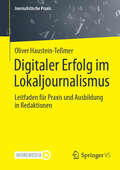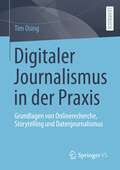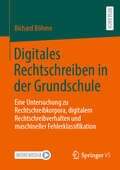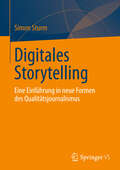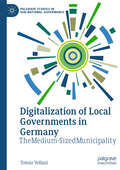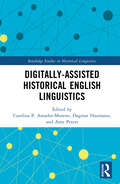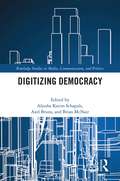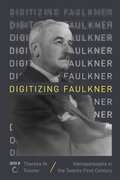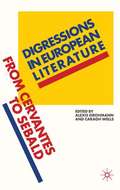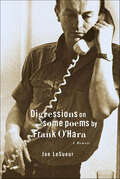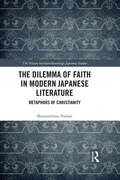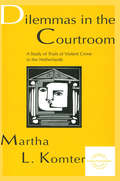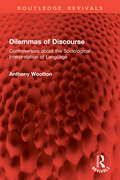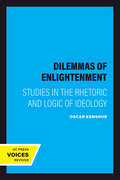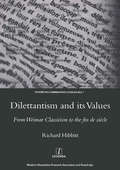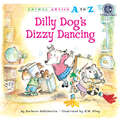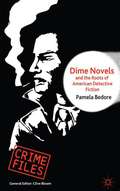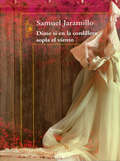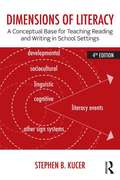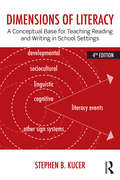- Table View
- List View
Digitaler Erfolg im Lokaljournalismus: Leitfaden für Praxis und Ausbildung in Redaktionen (Journalistische Praxis)
by Oliver Haustein-TeßmerDieses Buch hilft Führungskräften und Mitarbeitenden in Redaktionen, digitale Werkzeuge erfolgreich anzuwenden. Es richtet sich an erfahrene und neu einsteigende Journalistinnen und Journalisten. Im Fokus stehen dringende Fragen der digitalen Transformation: Wie erreichen lokale Medien mehr und jüngere Menschen? Wie gewinnen und halten regionale Verlage Abonnentinnen und Abonnenten online? Die Leserinnen und Leser lernen, welche Strategien eine digitale Arbeitsweise befördern. Der Leitfaden erläutert datenorientiertes Planen und Produzieren sowie die Arbeit mit Zielgruppen und deren Bedürfnissen (User Needs). Checklisten, Grafiken und Tabellen sorgen für Übersicht. Es gibt viele Praxisbeispiele; Interviews mit Fachleuten bieten zusätzliche Einblicke. Der Autor geht auf Trends wie konstruktiven Journalismus ein und zeigt, wie journalistische Qualität mit dem Einsatz generativer Künstlicher Intelligenz vereinbar ist. Ein Schwerpunkt liegt auf Karrierechancen und Ausbildung. Dabei berücksichtigt der Autor sowohl die Perspektive journalistischer Talente als auch die veränderten Anforderungen an Volontariate und ausbildende Medienunternehmen. Ziel ist es zu zeigen, wie vielfältig Journalismus als Beruf in der digitalisierten Gesellschaft wirken kann. Per App: einfach die SN More Media App kostenfrei herunterladen, ein Bild oder einen Link mit dem Play-Button scannen und sofort die Videos auf Smartphone oder Tablet ausspielen.
Digitaler Journalismus in der Praxis: Grundlagen von Onlinerecherche, Storytelling und Datenjournalismus
by Tim OsingDieses Lehrbuch vermittelt die besonderen Möglichkeiten des digitalen Journalismus. Es erklärt mit großem Praxisbezug und vielen Beispielen digitales Storytelling, zeigt Techniken des Datenjournalismus und liefert Tipps und Tools für die Recherche im Internet. Um einer digitalisierten Welt gerecht werden zu können, müssen Journalist*innen sich dieses Handwerk aneignen – und es intuitiv einsetzen können, da im hektischen Alltag einer Online-Redaktion nicht viel Zeit bleibt. Wer Open Data richtig nutzen, Geschichten multimedial erzählen und Fakten zügig überprüfen kann, hebt sich im Internet und den sozialen Medien entscheidend ab.
Digitales Rechtschreiben in der Grundschule: Eine Untersuchung zu Rechtschreibkorpora, digitalem Rechtschreibverhalten und maschineller Fehlerklassifikation
by Richard BöhmeDer Erwerb der Rechtschreibung ist eine äußerst anspruchsvolle Aufgabe. Digitale Medien haben das Potenzial, Schüler*innen dabei durch adaptive Angebote zu unterstützen. Voraussetzung dafür sind Machine-Learning-Verfahren, die Rechtschreibfehler von Schüler*innen zuverlässig klassifizieren. Allerdings bestehen in diesem Zusammenhang einige Entwicklungs- und Forschungsdesiderate. Die folgenden wurden adressiert: Zunächst wurden gängige Grund- und Orientierungswortschätze einer umfassenden Korpusanalyse unterzogen. In den Ergebnissen zeigt sich, dass zwar ein Großteil der Wörter graphematisch, aber nur ein Bruchteil rein phonematisch herzuleiten ist. Unter Verwendung der analysierten Wörter und einer eigens entwickelten Rechtschreib-App wurde das digitale, prozessbezogene Rechtschreibverhalten von Schüler*innen mit hoher und niedriger Rechtschreibkompetenz untersucht. Die Ergebnisse machen deutlich, dass sich die Schüler*innen u.a. in ihrer Fehlersensibilität, ihrer aktiven Auseinandersetzung mit Fehlerkorrekturen und ihrem systematischen Vorgehen beim Hypothesentesten unterscheiden. Die fehlerhaften Verschriftungen der Schüler*innen wurden wiederum dafür genutzt, um Machine-Learning-Algorithmen zu trainieren. Die Evaluation zeigt, dass Rechtschreibfehler damit äußerst zuverlässig klassifiziert werden können.
Digitales Storytelling: Eine Einführung in neue Formen des Qualitätsjournalismus
by Simon SturmDas Buch gibt einen Einblick in die neuen Erzählweisen des digitalen Journalismus. Es untersucht die Auswirkungen der Digitalisierung auf die Medienbranche und den mit ihr verbundenen Wandel journalistischer Darstellungsformen. Dabei geht es auch um die Möglichkeiten des journalistischen Storytellings auf mobilen Endgeräten wie Tablet-Computern. Es wird eine neuartige Typologie von Darstellungsformen entwickelt, die u ber die klassischen Text-, Audio- und Fernsehformate hinaus digitales Storytelling ermöglicht.
Digitalization of Local Governments in Germany: The Medium-Sized Municipality (Palgrave Studies in Sub-National Governance)
by Tomás VellaniThis book provides an in-depth analysis of the digital policy of medium-sized municipalities in Germany. Mostly ignored by empirical research, the size of these municipalities has been characterized both as an advantage and a limitation for digitalization, with scholars alternately emphasizing agility and shorter administrative paths on the one hand, and the lack of capacity and economies of scale on the other. Utilising a mixed methods approach combining process-tracing and web scraping, the book analyzes the characteristics of digital policy in medium-sized municipalities, and the effects of digitalization governance on service provision. It traces the historical trajectories of digitalization in pioneering municipalities, examines which factors influence favorable digital transformations, and analyzes the organizational structures dedicated to digitalization. The book also puts forward a typology to classify municipalities according to their digital governance, quantitatively describes the landscape of medium-sized municipalities, and delivers insights on the effects of governance on digital services. It will appeal to scholars, students and practitioners of public administration, local government and digitalization.
Digitally-assisted Historical English Linguistics (Routledge Studies in Historical Linguistics)
by Amador-Moreno, Edited by Carolina P. Dagmar Haumann Arne PetersThis collection features different perspectives on how digital tools are changing our understanding of language varieties, language contact, sociolinguistics, pragmatics, and dialectology through the lens of different historical contexts. With a clear focus on English, chapters in the volume showcase a broad range of digital methods and approaches that can contribute to advancing the study of historical linguistics. Visualization tools and corpus-linguistic techniques are part of the methodologies included in the volume. The chapters present empirically based research and discuss theoretical aspects that emphasize how digitalization is changing our analysis of different domains of language, going from phonology to specific grammatical/morphosyntactic and lexical features, to discourse-related issues more broadly. This book will be of interest to scholars of the history of the English language, historical linguistics, corpus linguistics, and digital humanities.
The Digitally Disposed: Racial Capitalism and the Informatics of Value (Electronic Mediations #61)
by Seb FranklinLocates the deep history of digitality in the development of racial capitalism Seb Franklin sets out a media theory of racial capitalism to examine digitality&’s racial-capitalist foundations. The Digitally Disposed shows how the promises of boundless connection, flexibility, and prosperity that are often associated with digital technologies are grounded in racialized histories of dispossession and exploitation. Reading archival and published material from the cybernetic sciences alongside nineteenth-century accounts of intellectual labor, twentieth-century sociometric experiments, and a range of literary and visual works, The Digitally Disposed locates the deep history of digitality in the development of racial capitalism.Franklin makes the groundbreaking argument that capital&’s apparently spontaneous synthesis of so-called free individuals into productive circuits represents an &“informatics of value.&” On the one hand, understanding value as an informatic relation helps to explain why capital was able to graft so seamlessly with digitality at a moment in which it required more granular and distributed control over labor—the moment that is often glossed as the age of logistics. On the other hand, because the informatics of value sort populations into positions of higher and lower capacity, value, and status, understanding their relationship to digitality requires that we see the digital as racialized and gendered in pervasive ways.Ultimately, The Digitally Disposed questions the universalizing assumptions that are maintained, remade, and intensified by today&’s dominant digital technologies. Vital and far-reaching, The Digitally Disposed reshapes such fundamental concepts as cybernetics, informatics, and digitality.
Digitizing Democracy (Routledge Studies in Media, Communication, and Politics)
by Aljosha Karim Schapals Axel Bruns Brian McNairWhat are the key challenges facing our increasingly digitized democracy, and how might we as citizens contribute to resolving them? This book explores these questions, adopting a multi-disciplinary approach that combines work from media studies, journalism studies, and political science scholars, and draws on trends in countries including Australia, the United States, the United Kingdom, Egypt, and Indonesia. The book is divided into four main themes: (1) the impact of digital communication on politics and government; (2) the future of news and journalism in the network society; (3) the potential of digital media to enhance civic engagement and social inclusion; and (4) visions for the future of digital democracy.
Digitizing Faulkner: Yoknapatawpha in the Twenty-First Century
by Johannes Burgers John Michael Corrigan Ren Denton Jennie Joiner Erin Penner Stephen Railton Christopher Rieger Ben Robbins Melanie Benson Taylor Lorie WatkinsFor more than eighty years, Faulkner criticism has attempted to "see all Yoknapatawpha," the fictional Mississippi county in which the author set all but four of his novels as well as more than fifty short stories. One of the most ambitious of these attempts is the ongoing Digital Yoknapatawpha, an online project that is encoding the texts set in Faulkner’s mythical county into a complex database with sophisticated front-end visualizations. In Digitizing Faulkner, the contributors to the project share their findings and reflections on what digital research can mean for Faulkner studies and, by example, other bodies of literature.The essays examine Faulkner’s characters, events, locations, and visualizations, as well as offering more theoretical reflections on digitally mapping specific texts and stories, including the pedagogical implications of this digital approach. Digitizing Faulkner explores how a twenty-first-century research tool intersects with twentieth-century sensibilities, ideologies, behaviors, and material cultures to modify and enhance our understanding of Faulkner’s texts.Contributors:Johannes Burgers, Ashoka University * John Michael Corrigan, National Chengchi University, Taiwan * Ren Denton, East Georgia State College * Jennie Joiner, Keuka College * Erin Penner, Asbury University * Stephen Railton, University of Virginia * Christopher Rieger, Southeast Missouri State University * Ben Robbins, University of Innsbruck * Melanie Benson Taylor, Dartmouth College * Lorie Watkins, William Carey University
Diglossia and Language Contact
by Lotfi SayahiThis volume provides a detailed analysis of language contact in North Africa and explores the historical presence of the languages used in the region, including the different varieties of Arabic and Berber as well as European languages. Using a wide range of data sets, it provides a comprehensive analysis of the mechanisms of language contact under classical diglossia and societal bilingualism, examining multiple cases of oral and written code-switching. It also describes contact-induced lexical and structural change in such situations and discusses the possible appearance of new varieties within the context of diglossia. Examples from past diglossic situations are examined, including the situation in Muslim Spain and the Maltese Islands. An analysis of the current situation of Arabic vernaculars, not only in the Maghreb but also in other Arabic-speaking areas, is also presented. This book will appeal to anyone interested in language contact, the Arabic language, and North Africa.
Digressions in European Literature
by Alexis Grohmann Caragh WellsWith studies of, amongst others, Miguel de Cervantes, Anton Chekhov, Charles Baudelaire and Henry James, this landmark collection of essays is a unique and wide-ranging exploration and celebration of the many forms of digression in major works by fifteen of the finest European writers from the early modern period to the present day.
Digressions on Some Poems by Frank O'Hara: A Memoir
by Joe LeSueurAn unprecedented eyewitness account of the New York School, as seen between the lines of O'Hara's poetryJoe LeSueur lived with Frank O'Hara from 1955 until 1965, the years when O'Hara wrote his greatest poems, including "To the Film Industry in Crisis," "In Memory of My Feelings," "Having a Coke with You," and the famous Lunch Poems—so called because O'Hara wrote them during his lunch break at the Museum of Modern Art, where he worked as a curator. (The artists he championed include Jackson Pollock, Joseph Cornell, Grace Hartigan, Jane Freilicher, Joan Mitchell, and Robert Rauschenberg.) The flowering of O'Hara's talent, cut short by a fatal car accident in 1966, produced some of the most exuberant, truly celebratory lyrics of the twentieth century. And it produced America's greatest poet of city life since Whitman.Alternating between O'Hara's poems and LeSueur's memory of the circumstances that inspired them, Digressions on Some Poems by Frank O'Hara is a literary commentary like no other—an affectionate, no-holds-barred memoir of O'Hara and the New York that animated his work: friends, lovers, movies, paintings, streets, apartments, music, parties, and pickups. This volume, which includes many of O'Hara's best-loved poems, is the most intimate, true-to-life portrait we will ever have of this quintessential American figure and his now legendary times.
Dikengkeng Tsa Tshepo: UBC Contracted
by P.R.S. MaphikeKe boikarabelo ba batswadi ho hodisa ngwana eo. Batho bao e seng badumedi ba fumana bothata. Kgang o ne a tshajwa motseng wa habo. Eitse hoba Mmopi a ba putse ka lesea, a qalella ho ngongoreha ka hore ngwana eo o tla fetoha lejakane a lebale meetlo.
Dikengkeng Tsa Tshepo: UBC Uncontracted
by P.R.S. MaphikeKe boikarabelo ba batswadi ho hodisa ngwana eo. Batho bao e seng badumedi ba fumana bothata. Kgang o ne a tshajwa motseng wa habo. Eitse hoba Mmopi a ba putse ka lesea, a qalella ho ngongoreha ka hore ngwana eo o tla fetoha lejakane a lebale meetlo.
The Dilemma of Faith in Modern Japanese Literature: Metaphors of Christianity (Nissan Institute/Routledge Japanese Studies)
by Massimiliano TomasiThe first book-length study to explore the links between Christianity and modern Japanese literature, this book analyses the process of conversion of nine canonical authors, unveiling the influence that Christianity had on their self-construction, their oeuvre and, ultimately, the trajectory of modern Japanese literature. Building significantly on previous research, which has treated the intersections of Christianity with the Japanese literary world in only a cursory fashion, this book emphasizes the need to make a clear distinction between the different roles played by Catholicism and Protestantism. In particular, it argues that most Meiji and Taishō intellectuals were exposed to an exclusively Protestant and mainly Calvinist derivation of Christianity and so it is against this worldview that the connections between the two ought to be assessed. Examining the work of authors such as Kitamura Tōkoku, Akutagawa Ryūnosuke and Nagayo Yoshirō, this book also contextualises the spread of Christianity in Japan and challenges the notion that Christian thought was in conflict with mainstream literary schools. As such, this book explains how the dualities experienced by many modern writers were in fact the manifestation of manifold developments which placed Christianity at the center, rather than at the periphery, of their process of self-construction. The Dilemma of Faith in Modern Japanese Literature will be of great interest to students and scholars of Japanese modern literature, as well as those interested in Religious Studies and Japanese Studies more generally.
Dilemmas in the Courtroom: A Study of Trials of Violent Crime in the Netherlands (Everyday Communication Ser.)
by Martha L. KomterInteractional dilemmas occur when participants are required to engage in two contradictory activities at the same time or orient to two conflicting goals. The existence of such dilemmas provides a context for interactants to be creative, pro-active, and indeed strategic as they maneuver between the numerous demands placed on them and produce behavior that fits the ongoing communication episode. Trials are one such episode in which the various participants -- in this case, the judge, the defendant, and lawyers -- experience interactional dilemmas and work to resolve these through their behavior. This volume offers an analysis of both the institutional factors which promote dilemmas during court proceedings and the interactional behaviors used by trial participants to navigate these dilemmas. Using ethnomethodology, conversation analysis, and ethnography as complementary methods, Komter's research combines an understanding of the legal rules for courtroom procedure and crime descriptions, with details of actual trial discourse. The analysis is based upon fieldnotes of 48 trials and audiotapes of 31 trials, all related to violent crimes and occurring in courtrooms in Amsterdam, Utrecht, and Haarlem. Dilemmas reflect enduring conflicts of interest or values; they derive from the ongoing institutional and interactional positions of the various courtroom participants. Komter points to the existence of dilemmas and to their role in shaping unfolding interaction during the trials. She especially highlights the different dilemmas faced by judges and suspects, and the ways in which behavior on the part of one constrains that of the other. She further reveals the wide variety of ways in which interactants handle dilemmas -- their innovativeness and resourcefulness -- and the consequences these have for the unfolding interaction and the court's ultimate judgment. Of course, dilemmas are not only relevant to an understanding of judicial interaction. This study has implications for other contexts, since concerns with credibility, blame, responsibility, and morality -- and their opposites -- are incorporated into many everyday interactions. This volume examines behavior that is quite specific to a single context, yet its conclusions bear upon a wide range of communication events. Of interest to scholars in communication, linguistics, anthropology, criminal justice, or those with interests in ethnomethodology, conversation analysis, and ethnography.
Dilemmas of Discourse: Controversies about the Sociological Interpretation of Language (Routledge Revivals)
by Anthony WoottonFirst Published in 1975, Dilemmas of Discourse brings together strands of arguments from disciplines like sociology, anthropology, linguistics and philosophy to explore the debate around the issue of deciding the meaning of what people may say. Can the meaning of words be described satisfactorily as a bundle of semantic features? Can speech acts such as promising and insulting be described as only occurring when a particular form of speech is used in a particular kind of context? Do sociolinguistic rules have a bearing on the problem of extracting the meaning of what people say? What sorts of implications does ethnomethodology have for areas of traditional sociological interest in language such as vocabularies of motives or the relation of language used to social class? These are some of the questions which the author sets out to answer with clarity and carefulness uncharacteristic of much writing on this subject. In general, Dr Wootton defends the ethnomethodological position, and when relating these arguments to developments in mainstream sociology responds to certain criticisms made of recent ethnomethodological writing. But he is also at pains to point out the necessity of subjecting ethnomethodological interpretations to explicit forms of evaluation and suggests some ways in which this might be done. This is a must read for students of sociology.
Dilemmas of Enlightenment: Studies in the Rhetoric and Logic of Ideology (The New Historicism: Studies in Cultural Poetics #26)
by Oscar KenshurOscar Kenshur combines trenchant analyses of important early-modern texts with a powerful critique of postmodern theories of ideology. He thereby contributes both to our understanding of Enlightenment thought and to contemporary debates about cultural studies and critical theory.While striving to resolve "dilemmas" occasioned by conflicting intellectual and political commitments, seventeenth- and eighteenth-century writers often relied upon ideas originally used by their enemies to support very different claims. Thus, they engaged in what Kenshur calls "intellectual co-optation." In exploring the ways in which Dryden, Bayle, Voltaire, Johnson, and others used this technique, Kenshur presents a historical landscape distinctly different from the one constructed by much contemporary theory.
Dilettantism and Its Values: From Weimar Classicism to the Fin De Siecle
by Richard Hibbitt"The concept of dilettantism has not always been associated with amateurism or superficiality. It played a significant role in French and German critical writing from the late eighteenth century until the fin de siecle, embracing notions such as apprenticeship, fruitful error, parody, aestheticism and scepticism. Attempts to define dilettantism in a binary relationship with art have often been defeated by a fundamental ambivalence towards its values. The major texts on the subject are Goethe and Schiller's unfinished 'dilettantism project' (1799) and Paul Bourget's essay on Ernest Renan (1882), although the term was also used by writers including Wieland, Baudelaire, Laforgue, Nietzsche, Hofmannsthal and Thomas Mann. In this wide-ranging study Richard Hibbitt provides the first book-length comparative analysis of the concept of dilettantism, tracing its chronological development and proposing a synthesis of its diverse aspects and values."
Dilly Dog's Dizzy Dancing (Animal Antics A to Z)
by Barbara deRubertisGet to know Alpha Betty&’s class in the award-winning, 26-book alphabet series ANIMAL ANTICS A TO Z! From Alexander Anteater to Zachary Zebra, it&’s one adventure after another. Zip along with these zany characters as they find new friends, test their talents, and have a rip-roaring good time! Dilly loves to dance. She darts! She dips! She dives through the air! But sometimes her dizzy dancing ends in a dreadful THUD. Can Dilly find a way to dance without the disasters? This series is a perfect read-aloud choice to help kids discover the joy of letter sounds and give them the phonics building blocks they need for reading success. With delightful illustrations by Paddington Bear illustrator R.W. Alley, ANIMAL ANTICS A TO Z is an excellent resource for parents and educators alike. Activities in each book plus free activities online add to the fun.Winner: Teachers&’ Choice Award for Children&’s BooksWinner: Teachers&’ Choice Award for the Family
Dime Novels And The Roots Of American Detective Fiction
by Pamela BedoreThis book reveals subversive representations of gender, race and class in detective dime novels (1860-1915), arguing that inherent tensions between subversive and conservative impulses theorized as contamination and containment explain detective fiction's ongoing popular appeal to readers and to writers such as Twain and Faulkner. "
Dime si en la cordillera sopla el viento
by Samuel JaramilloA partir de la mirada incesante e inquisitiva a una viejafotografía, el narrador de esta novela busca desentrañarlos misterios que ocultan las sonrisas de las tresjóvenes frente a la cámara, en un fugaz momento defelicidad. Este ejercicio abre las puertas a un poderosoesfuerzo de memoria y reflexión y a un impresionantey conmovedor relato de familia.Dime si en la cordillera sopla el viento reconstruye la historia decuatro generaciones de los Polanía, en el Huila, desde su instalación enDiamantina, la abrupta tierra que los verá florecer en los años 30,hasta la pérdida del patrimonio, la frustración de sus aspiracionessociales, la zozobra y el horror ante los primeros brotes de laviolencia que se generalizará en el país en los años sucesivos.Esta novela de Samuel Jaramillo es una obra de granaliento sobre los vientos de violencia política y transformaciónsocial que arrastraron a tantas familias colombianas a lo largo delsiglo xx, y un relato poético, dramático y cercano sobre la vitalidad yfragilidad de la lucha de sus protagonistas.
Dimensions of Literacy: A Conceptual Base for Teaching Reading and Writing in School Settings
by Stephen B. KucerThis popular text, now in its fourth edition, "unpacks" the various dimensions of literacy--linguistic and other sign systems; cognitive; sociocultural; and developmental--and at the same time accounts for the interrelationships among them. Distinguished by its examination of literacy from a multidimensional and interdisciplinary perspective, it provides a strong conceptual foundation upon which literacy curriculum and instruction in school settings can be grounded. Linking theory and research to practice in an understandable, user-friendly manner, the text provides in-depth coverage of the dimensions of literacy, includes demonstrations and "hands-on" activities, examines authentic reading and writing events that reflect key concepts, and summarizes the concepts in tables and figures. Changes in the Fourth Edition * Addresses academic language, new literacies/multiliteracies, and their relationship to literacy learning * More fully develops the developmental dimension of literacy in separate chapters on adult mediation and learner construction * Expands the discussion of multimodal literacies * Extends and integrates the discussion of bilingualism and biliteracy throughout the text * Integrates instructional implications more fully throughout
Dimensions of Literacy: A Conceptual Base for Teaching Reading and Writing in School Settings
by Stephen B. KucerThis popular text, now in its fourth edition, "unpacks" the various dimensions of literacy--linguistic and other sign systems; cognitive; sociocultural; and developmental--and at the same time accounts for the interrelationships among them. Distinguished by its examination of literacy from a multidimensional and interdisciplinary perspective, it provides a strong conceptual foundation upon which literacy curriculum and instruction in school settings can be grounded. Linking theory and research to practice in an understandable, user-friendly manner, the text provides in-depth coverage of the dimensions of literacy, includes demonstrations and "hands-on" activities, examines authentic reading and writing events that reflect key concepts, and summarizes the concepts in tables and figures. Changes in the Fourth Edition* Addresses academic language, new literacies/multiliteracies, and their relationship to literacy learning* More fully develops the developmental dimension of literacy in separate chapters on adult mediation and learner construction* Expands the discussion of multimodal literacies* Extends and integrates the discussion of bilingualism and biliteracy throughout the text* Integrates instructional implications more fully throughout
Dimensions of Phonological Stress
by Jeffrey Heinz Rob Goedemans Van Der Hulst HarryStress and accent are central, organizing features of grammar, but their precise nature continues to be a source of mystery and wonder. These issues come to the forefront in acquisition, where the tension between the abstract mental representations and the concrete physical manifestations of stress and accent is deeply reflected. Understanding the nature of the representations of stress and accent patterns, and understanding how stress and accent patterns are learned, informs all aspects of linguistic theory and language acquisition. These two themes - representation and acquisition - form the organizational backbone of this book. Each is addressed along different dimensions of stress and accent, including the position of an accent or stress within various prosodic domains and the acoustic dimensions along which the pronunciation of stress and accent may vary. The research presented in the book is multidisciplinary, encompassing theoretical linguistics, speech science, and computational and experimental research.
